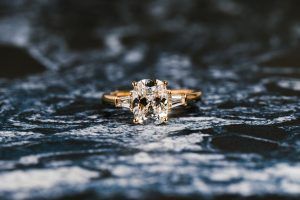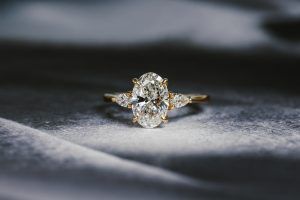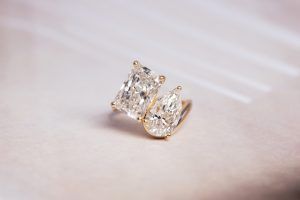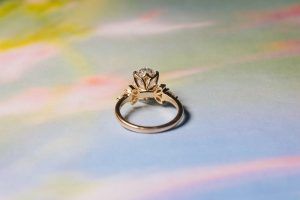
written by VJ
Guide to Picking the Perfect Pear Shaped Diamond Ring
Today’s conversation is about finding the juiciest pear shaped diamond ring out there. Let’s dive right into it 🍐
There are a lot of things to consider when finding the perfect pear.
We’re going to start off with issues of quality. We want to make sure that you’re going to pick a pear diamond that is not a dud.
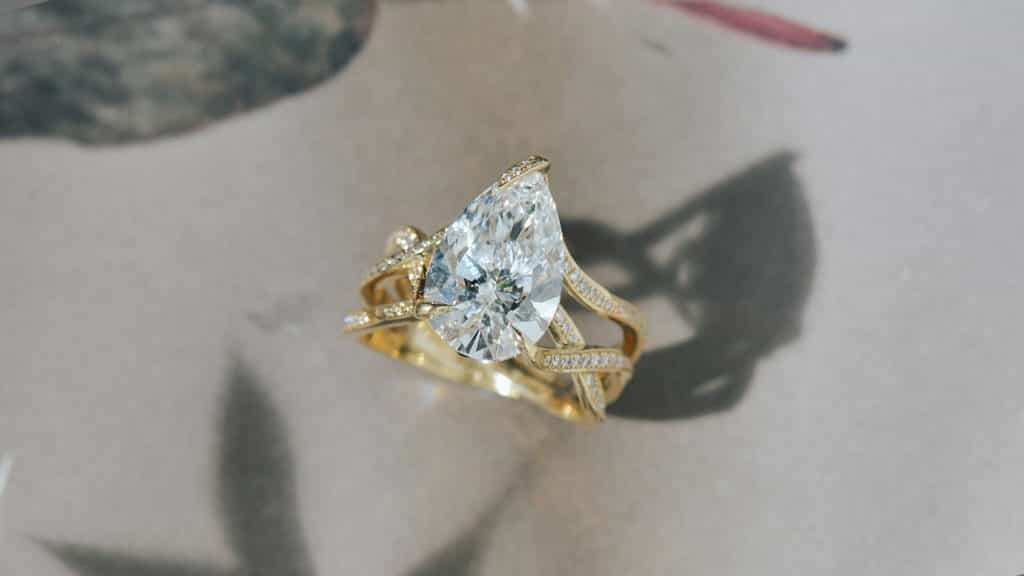
We’re also going over the actual shape and dreaded bow-tie effect that people will often hear or read about.
We want to do an overview of the available choices for you. Like, the length to width proportion.
Do you want to wear the pear diamond ring pointed up or down?
And lastly, we’re going to give you two solid ways to properly assess pear diamonds so that you can buy the perfect pear-shaped engagement ring.
Let’s talk about quality…
Shape
It’s important to consider that the cutter is literally chiselling at the hardest substance on Earth. They want to make sure that it looks like a nice pear.
A pear-cut diamond consists of the head, the shoulder, the belly, the wing, and the point.
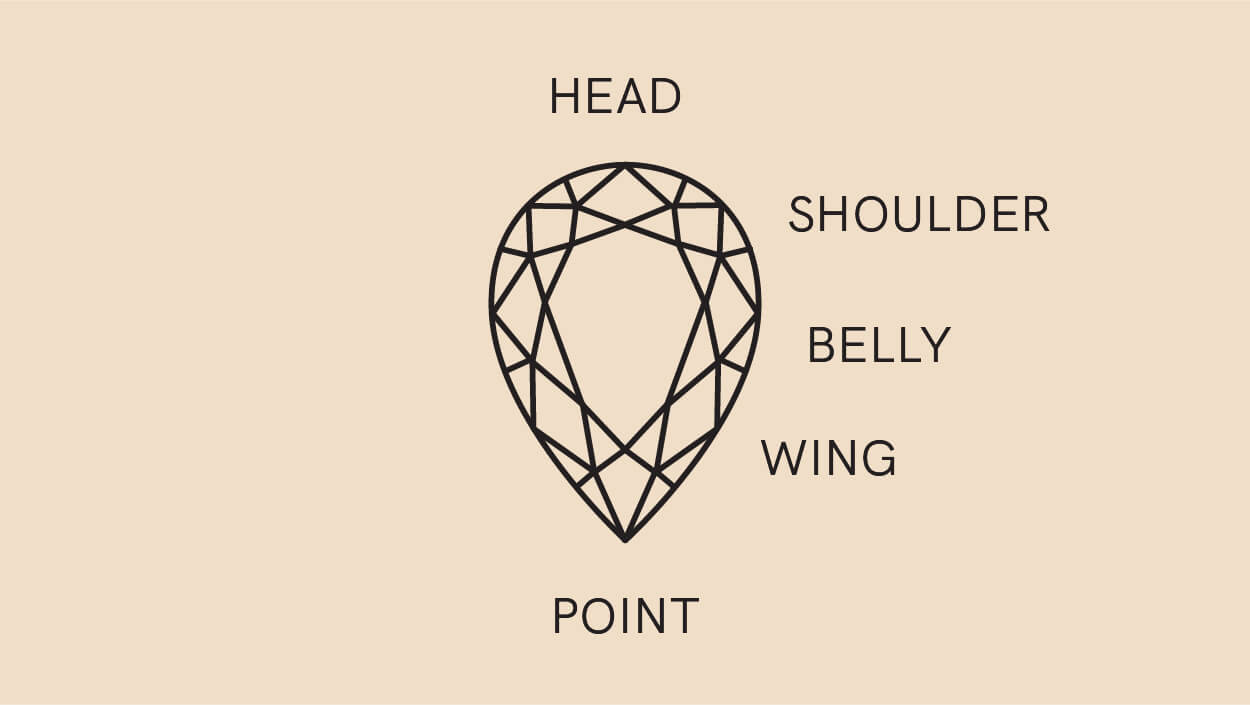
When it comes to fancy diamond shapes, it all comes down to the art of the cut.
There is no standardized way to cut this. The shape is really subjective to the design and the cut of the cutter’s hands.
There are pear cut engagement rings with a high shoulder where it’s a bit too high to the head that it becomes triangular, like an arrowhead.
There are also ones where the wing is really straight and loses its curvature. The curve should be there to make a pear look nice and plump.
Other things are easier to spot. Like, there are some pears where the cut itself is asymmetrical. So you have a pear-cut diamond where the shoulder is high on one side and a little bit rounded on the other side.
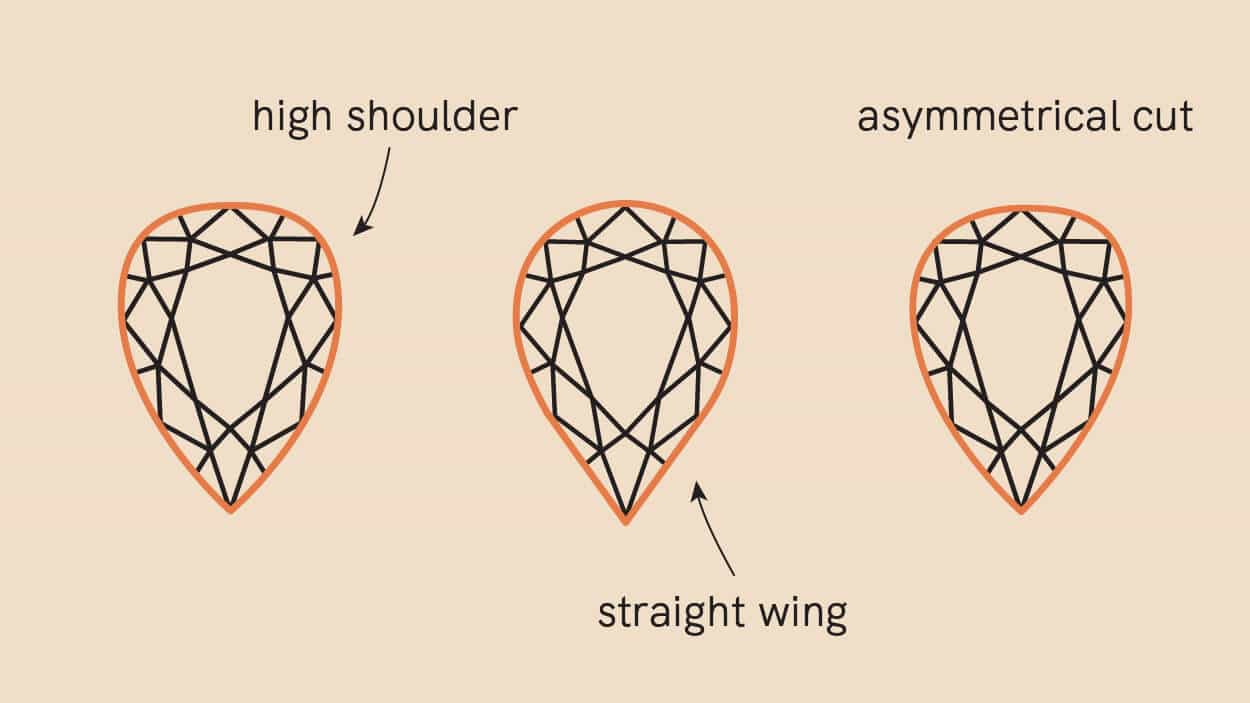
Next Up: Pear Diamond Carat Weight
Carat weight is already something that we addressed in a separate article.
Although this is the concept that most people focus on, it is the most meaningless concept.
The same principle applies to pears. You can’t judge a pear by its carat weight.
Okay. So take a look at these two pears and observe the carat weight difference versus the actual size difference. See now? Completely meaningless. The way that pears are proportionately cut is not standardized. Therefore, you don’t want to focus on carat for pears.

And it’s undeniable that these two stones are different in size and sparkle. The problem is that the sparkle has entirely to do with CUT!
Since the cut on pears are not standardized, you can’t look at the grade alone to assess the cut.
You actually have to look at the diamond and compare them with other pears so that you can make sure that the sparkle is top-notch.

Remember the dreaded bow tie effect!
We’re not talking about this bow tie – – -> 🎀
But the bow-tie effect that happens in pears. If you haven’t heard about it, it has to do with how the pear diamond has been cut. Often, it leaves an undesirable black streak going across the pear, resembling a bow tie or hazard sign ⚠️☢️
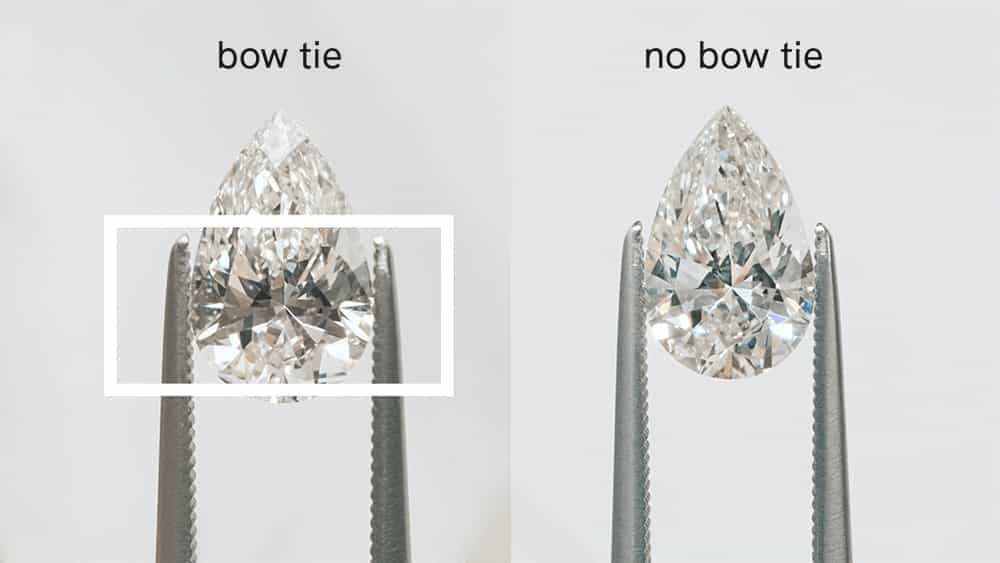
personal choice
Now that we’ve gotten through all the quality concerns, we can get to the fun stuff and talk about your personal choice.
We want you to consider first the ideal pear diamond proportion
Do you prefer pears that are plump and more rounded? Or do you want the pear to be more tall and skinny?
Do you like that it’s elongating your finger? Or do you want it a little bit more lusciously plump?
We walk our clients through to show them different proportions. Their eyes 👀 will tell them which one they’re leaning towards.
Another effective way to determine the perfect pear diamond ring is by trying it on your hand. Now, it’s obviously very easy for our clients that we meet in-store. However, there are some that we don’t get to see personally. And for that, we actually superimpose the diamond of their choosing onto a picture of their hand.

This way, they’ll be able to compare the proportions of the pear and how it looks on their actual hand.
This process is part of the unique online experience clients can get in our one-of-a-kind virtual studio.

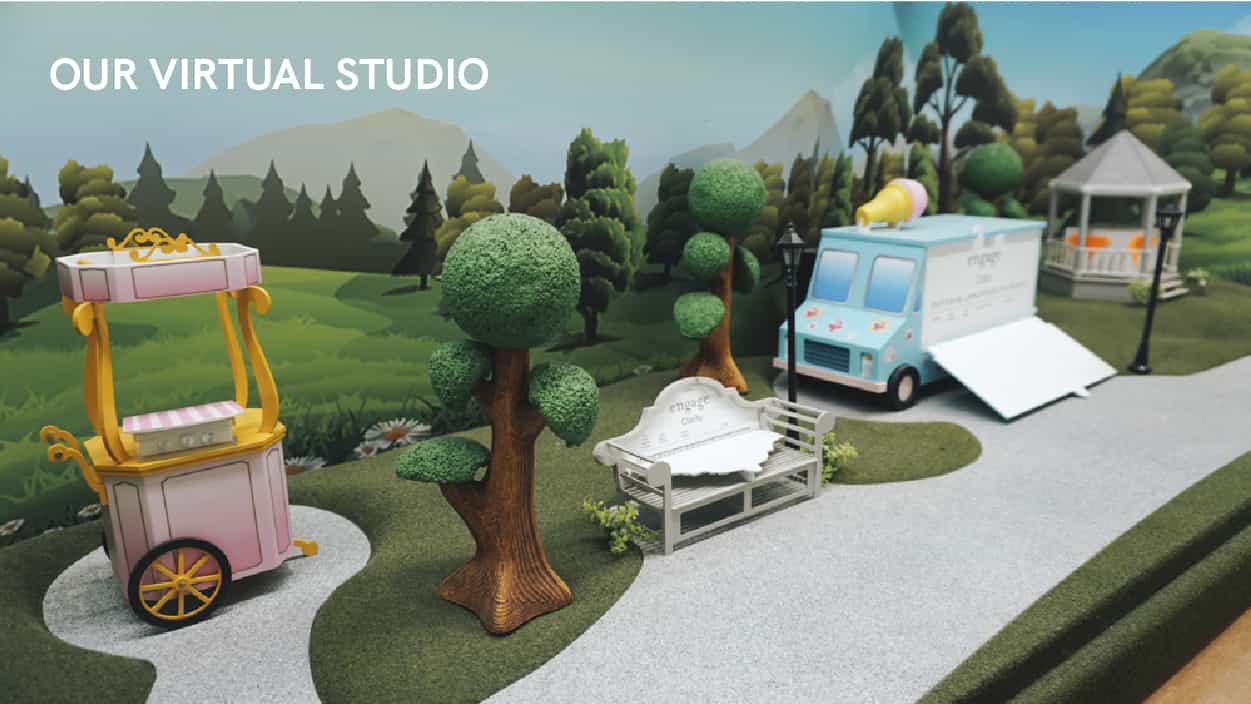
Another thing to consider is the color
So the pear is one of the more unforgiving shapes when it comes to color. When we mean unforgiving, we mean that the stone’s body color is easier to see for some people, than a round cut. For those of you who aren’t familiar with the concept of color grade for diamonds, you should read this to learn more.

Because of that, we recommend the blind color test. Essentially, we are showing our clients a lineup of stones with different colors, to find out how color sensitive they are.
And finally, how do you want to wear your pear shaped diamond ring, point up or point down?
Again, this totally comes down to personal preference. It depends on the design you’ve chosen and how you like it. Some of our clients love to have the point facing them; others like it facing out towards their audience.
You know, you might find that you like to wear the pear point up or point down, depending on the day. Or there might be a proportion that you love, and you stick with that, and that’s how you wear it every single day.
All right, we’re nearing the end of this article…
And we’re going to address how to evaluate those juicy pears that you’re considering.
#1
It is essential to look at the pear unset and flat.
You want to look at multiple stones on the same surface, side by side. Otherwise, you wouldn’t be able to tell if they were uneven. It distorts what is really there.

#2
The stones should be seen in three different lighting conditions.
The first kind of lighting should be by a window, not direct sunlight. It shouldn’t have any artificial lighting.
This allows you to see two different things. One, it’s going to help you assess if there’s something inherently wrong with this stone—things that are off the grade. Off the grade? Find out more about when buying a diamond ring and what to look for.
And two, this is where most of you will see diamond color differences.

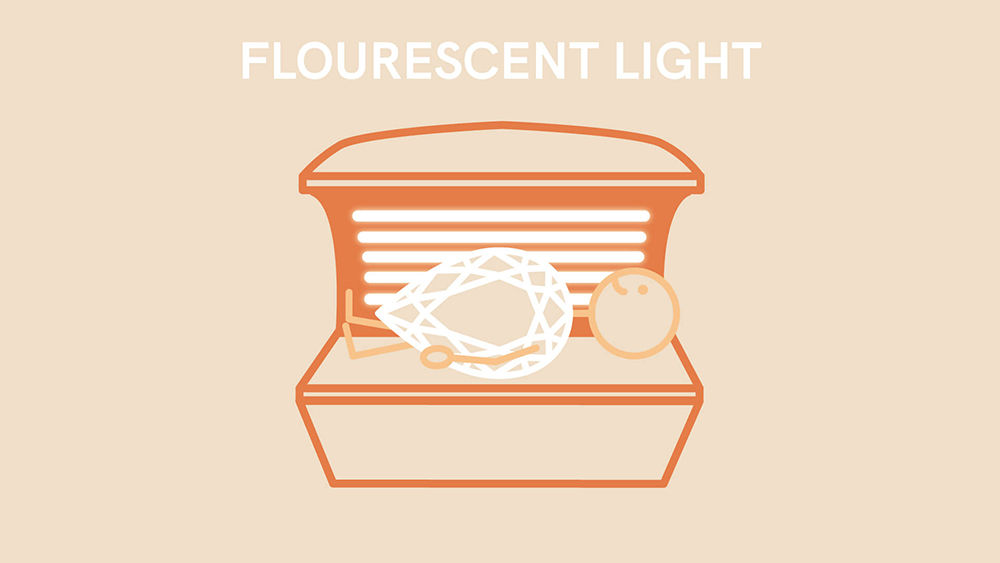
The second kind of lighting is under a flat fluorescent light. Seeing the pears under a fluorescent light allows you two things. One, it can help you see the shape of each stone individually. And second, it enables you to determine certain imperfections visible to the naked eye (and also find out which ones are eye clean).
The last kind of lighting is under halogen or LED light. With the halogen or LED light, we do a sparkle test to assess how each diamond sparkles by twisting and turning the diamonds’ surface.

Of course, comparing and assessing various diamonds are more manageable when you’re in-store with us. We have different lighting stations set up here. Not to worry though, we also have these lighting stations in our virtual studios!
We’ll walk you through each one and really be able to see what sticks out to you. So if you’re ready to pick the juiciest pear out there, whether that’s in-store or online in our virtual studios, reach out to us, and we are happy to start the conversation. Call or text us at 416.491.6060



